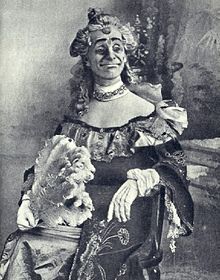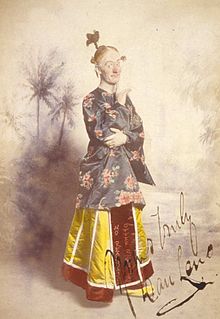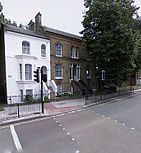- Dan Leno
-
 Leno in 1895
Leno in 1895
Dan Leno (20 December 1860 - 31 October 1904), born George Wild Galvin, was an English comedian and actor, famous for appearing in music hall and dozens of comic plays, pantomimes, Victorian burlesques and musical comedies during the Victorian era. He was one of the first members (and later leader) of the Grand Order of Water Rats.
Born in Marylebone, London, he began to entertain as a child. In 1864, he joined his parents on stage at the Cosmotheca Music Hall, Paddington, and he made his first solo appearance, aged nine, at the Britannia Music Hall, Glasgow. He adopted the stage name Dan Leno in 1884 and made his first performance under that name at the Foresters' Music Hall in Mile End, London the same year. He became increasingly popular during the 1890s and developed his act of talking about life's mundane subjects, mixed with surreal observations, and created a host of characters which he used to illustrate his stories. In 1901 and much in demand, he performed his "Huntsman" sketch for Edward VII at Sandringham. The monarch was so impressed that Leno became publicly known as "the king's jester".
Leno appeared in burlesque and many pantomimes, starring in the Drury Lane's famous annual christmas pantomimes, where he became known in the dame roles. Later in his career, he appeared in Edwardian musical comedies until 1903, although he suffered from alcoholism. This, together with his long association with dame and low comedy roles, prevented him from being taken seriously as an actor, and he was often turned down for Shakespearian roles. Leno began to behave in an erratic and furious manner, and he was finally committed to a mental asylum in 1903. He died soon after his discharge, aged 43.
Contents
Biography
Leno was born at 6 Eve Place, St Pancras, London.[1] He was the youngest of six children, including two brothers, Jack (1850 – 1893) and Henry, and a sister, Frances. Two others, Maurice and Louisa, died in infancy.[2] His parents were John Galvin (1828 – 1864) and his wife Louisa, née Dutton (1834 – 1891) who, together, performed in a music hall double act called "The Singing and Acting Duettists". They were also known professionally as Mr and Mrs Johnny Wild.[1] Having had very little schooling, Leno learned to entertain as a child and, in 1864, at the age of three, he joined his parents on stage at the Cosmotheca Music Hall, Paddington, under the billing "Infant Wonder, Contortionist, and Posturer".[1][3] His father died the same year at the age of 37 due partly to his alcoholism. In 1865 his mother married William Grant, an Irish comedian, who performed under the stage name of William Leno.[4]
The family home in Marlybone was demolished to make way for St Pancras railway station in 1866[5] and, as a result, Leno and his family moved north and settled in Liverpool.[4] Leno and his brother, Henry, who first taught Leno to dance, formed a clog dancing double act known as The Great Little Lenos.[2] Frances stayed behind and was brought up by her paternal uncle, Michael Galvin, in London, and Jack went to work away as a labourer. [2] Henry soon left the clog dancing act to become a labourer and returned to London, where he later founded a dancing school.[2] Leno became known as The Great Little Leno the Quintessence of Irish Comedians (meaning performer of comic songs)[2] when he made his first solo appeance, aged nine, at the Britannia Music Hall, Coventry.[4]
Leno's paternal grandfather, Maurice Galvin, was Irish.[2] He and his parents visited, and performed in, Ireland in 1869.[2] While there, he took the first of his two stage names, Dan Patrick.[1] The same year, Leno, his mother and stepfather, appeared in Belfast at the same time as Charles Dickens, who was giving lectures in local schools, and who encouraged the young Leno.[6]
Early career
 Leno in the pantomime Mother Goose
Leno in the pantomime Mother Goose
By 1880, Leno, along with his mother and step father, had formed The Comic Trio (Mr & Mrs Leno and Dan Patrick) In Their Really Funny Entertainments, Songs and Dances[1] and his clog dancing had become so good that he won the world championship at the Princess's Music Hall in Leeds.[2] As a result, he won a gold and silver belt weighing 44.5 oz (1.26 kg).[4] His biographer, J. Hickory Wood, described his act: "He danced on the stage; he danced on a pedestal; he danced on a slab of slate; he was encored over and over again; but throughout his performance, he never uttered a word".[2] He performed his clog dancing routine throughout the British isles with success, but found less interest in clog dancing among the London audiences, who preferred his comic songs.[3]
Leno moved to London in the mid-1880s and gained success with a new act, featuring comedy patter, dancing and song.[1] He made his first appearance as Dan Leno in three London music halls on the same night; the Foresters' Music Hall in Mile End, Middlesex Music Hall in Drury Lane and Gatti's-in-the-Road in 1885, where he earned £5 a week.[2][7] Though billed as "The Great Irish Comic Vocalist and Clog Champion", he slowly phased out his dancing in favour of character studies, such as Going to Buy Milk for the Twins[4] and When Rafferty Raffled his Watch.[1]
Pantomime
Leno's first appearance in pantomime was as Jack's mother in Jack and the Beanstalk which he performed at the Surrey Theatre in 1886,[4] starring the following year in Sinbad.[4] His performances proved popular with audiences, and he was hired in 1888 by Augustus Harris, manager at Drury Lane to appear in the theatre's popular annual Christmas pantomime productions, over the next dozen years, including Babes in the Wood (1888 and 1897), Jack and the Beanstalk (1889 and 1899), Beauty and the Beast (1890 and 1900), Humpty Dumpty (1891), Little Bo-peep (1892), Robinson Crusoe (1893), Dick Whittington and His Cat (1894), Cinderella (1895), Aladdin (1896) and Forty Thieves (1898).[4] He often played the pantomime dame to Marie Lloyd's principal girl.[3][1] His stage partner in many of these pantomimes was Herbert Campbell (1845–1904).[1] Leno and Campbell would use the script as a basis but improvise freely.[1] This was met with some scepticism by producers, who feared that the scenes would not be funny to audiences and observed that, in any event, they were rarely at their best until a few nights after opening.[1] This caused George Bernard Shaw to write of one appearance: "I hope I never again have to endure anything more dismally futile".[8]
The English essayist, parodist and caricaturist Max Beerbohm stated that "Leno does not do himself justice collaborating with the public but he was exceptional in giving each of his dames a personality of her own, from extravagant queen to artless gossip".[9] Leno and his regular foil Herbert Campbell were so popular that in Sleeping Beauty they caused the audience to laugh even when they could not see them.[1] Leno and Campbell would arrive on stage in closed palanquins and exchange the lines "Have you anything to do this afternoon, my dear?" – "No, I have nothing on", before being carried off again.[1]
Later career
During the 1890s, Leno set about creating various comedic characters using observations about life in London, including shopwalkers, grocer's assistants, beefeaters, huntsmen, racegoers, firemen, fathers, henpecked husbands, garrulous wives, pantomime dames, a police officer, a Spanish bandit, a fireman, and a hairdresser.[1] He would begin with one verse of a song, then enter into his monologue with the audience, particularly the You know Mrs. Kelly? routine.[3]
Leno went to America in 1897, where he was billed as "The Funniest Man On Earth".[1] One newspaper reported that the house roared its approval, while another complained that his English humour was out of date.[1] The following year he became the hero of Dan Leno's Comic Journal. Dan Leno: hys Booke was published in (1899) and was ghost written for him by T. C. Elder.[1]
It was during this period that Leno began to drink heavily, and by 1901 he became an alcoholic.[1] He also became frustrated at not being accepted as a serious actor and became obsessed with the idea of playing Richard III, inundating the actor–manager Sir Herbert Beerbohm Tree with his proposals.[1] Nevertheless, in Britain, Leno proved to be so popular that he entertained Edward VII at Sandringham House in 1901, becoming the first music hall performer to give a Royal Command Performance, earning him the nickname the King’s Jester.[10] A journalist wrote that he was probably the highest paid funny man in the world.[11]
His problems with alcohol caused him to display frequent bouts of erratic behaviour that began to affect his work.[1] The angry outbursts were a result of his diminishing ability to remember his lines and inaudibility in performance.[1] His behaviour caused so much concern that he was sent to an asylum for a while for treatment in 1903.[1]
Personal life
In 1883, Leno met Sarah Lydia Reynolds (1962 – 1935), a Birmingham born comedy singer, whom he met while appearing in Sunderland.[2] They married in 1884 in a discreet ceremony at St. George's Church, Hulme, in Manchester, soon after the birth of their first daughter, Georgina.[1] Of their six children, three – Ernest, Sidney, and May were to follow their father on to the stage. Sidney later performed as Dan Leno Jr.
Leno owned two acres of land at the back of his house in Clapham Park, where he produced cabbages, potatoes, poultry, butter and eggs, of which he would send dozens out as Christmas presents.[12] At his peak, Leno earned £250 a week and regularly gave away large sums of money.[1] He was the sixteenth member of the entertainment charity Grand Order of Water Rats and became its leader, the King Rat, in 1891, 1892 and 1897,[13] and was later president of the Music Hall Benevolent Fund.[1] He also financially supported his mother and stepfather when they retired.[14]
Death
Leno died at his home in Camberwell, London on 31 October 1904, aged 43. A few months earlier, he had been released from the mental asylum where he had been treated for his erratic behaviour.[1] His cause of death at the time was cited as exhaustion, but his cause of death was recorded as general paralysis of the insane, a euphemism for tertiary syphilis.[1]
Thousands of fans lined the route to Lambeth Cemetery,[15] and it was the biggest funeral for an actor or comedian since the death of David Garrick. Max Beerbohm later said of Leno's death: "So little and frail a lantern could not long harbour so big a flame".[16] His memorial is maintained by the Grand Order of Water Rats, which commissioned the restoration of his grave in 2004.[17] The inscription reads, Here sleeps the King of Laughter-Makers. Sleep well, dear heart, until the King of Glory awakens thee.[18]
The comedian and actor Stanley Lupino was buried next to Leno in 1942.[19]
Reputation and legacy
Here was a man unlike anyone else we had ever seen. That face so tragic, with all the tragedy that is writ on the face of a baby monkey, yet ever liable to relax its mouth into a sudden wide grin and to screw up its eyes to vanishing point over some little triumph wrested from fate.
“”Max Beerbohm (1953) [20]Although he performed in London for less than 20 years, Leno gained a legend like status. The essayist and theatre critic, Max Beerbohm was an admirer of Leno and often commented on him and his performances. Beerbohm wrote: "Unlike Albert Chevalier, Leno shifted the centre of gravity from song to patter. His theme was as ever, the sordidness of the lower middle class, seen from within. Yet, in his hand, how gloriously it blazed, illuminating and warming! All that trite and unlovely material, how new and beautiful it became for us through Dan Leno's genius!"[21]
In 1898, Beerbohm replaced George Bernard Shaw as the theatre critic for The Saturday Review and wrote: "The mass of people, when it seeks pleasure, does not want to be elevated: it wants to laugh at something beneath its own level. Just as I used to go to Music Halls that I might feel my superiority to the audience, so does the audience go that it might compare itself favourably with the debased rapscallions of the songs.[22]
Peter Ackroyd wrote a novel, Dan Leno and the Limehouse Golem in 1994, which was also published under the title The Trial of Elizabeth Cree.[1] Charles Chaplin later cited Leno as an influence on his career, calling him "the greatest comedian since Grimaldi."[1]
A blue plaque was erected by the Greater London Council at his former address, 56 Akerman Road, Camberwell, in the London Borough of Lambeth, in 1962.[23][24]
References
- ^ a b c d e f g h i j k l m n o p q r s t u v w x y z aa ab ac Hogg, James. Leno, Dan Oxford Dictionary of National Biography, Oxford University Press, accessed November 2011
- ^ a b c d e f g h i j k "Lost Lives: Dan Leno", BillGreenwell.com, accessed 15 November 2010
- ^ a b c d "Dan Leno". Theatre and Performance. Victoria and Albert Museum. http://www.vam.ac.uk/collections/theatre_performance/features/history_of_music_halls/music_hall_stars/dan_leno/index.html. Retrieved 2011-15-02.
- ^ a b c d e f g h Leno, Dan. Dan Leno: hys booke, Greening & Co. (1901), accessed 19 November 2011
- ^ St Pancras railway station history and restoration project, Stpancras.com, accessed 19 November 2011
- ^ Brandreth, p. 12
- ^ The history of Foresters music hall, Mile End, Arthur Lloyd.co.uk, accessed 19 November 2011
- ^ Brandreth, p. 45
- ^ Beerbohm, p. 350
- ^ "Actors at Sandringham; First 'Royal Command' Performance Before King Edward", The New York Times, 1 December 1901, p. 7
- ^ Blumenfeld, p. 167
- ^ Blumenfeld, p. 166
- ^ The Grand Order of Water Rats, Gowr.net, accessed 17 November 2011
- ^ Wood, p. 99
- ^ Dan Leno burial, at findagrave.com, accessed November 2011
- ^ Beerbohm, p. 349
- ^ "Dan Leno". Find a Grave. http://www.findagrave.com/cgi-bin/fg.cgi?page=gr&GRid=6380148. Retrieved 17 November 2011.
- ^ FindagraveDan Leno burial, accessed November 2011
- ^ Stanley Lupino burialcourtesy of findagrave.com, accessed November 2011
- ^ Beerbohm, p. 350
- ^ Beerbohm, p. 349
- ^ Beerbohm, p. 41
- ^ "Music Hall and Variety Artistes Commemorative Plaques". arthurlloyd. http://www.arthurlloyd.co.uk/Plaques/MusicHallArtistesCommemorativePlaques.htm. Retrieved 2011-10-10.
- ^ "Open Plaques". Open Heritage. http://openplaques.org/plaques/613. Retrieved 2011-10-10.
Sources
- Beerbohm, Max. Around Theatres, Rupert Hart-Davis: London, new edition, 1953
- Blumenfeld, R. D. RDB's Diary 1887–1914. London, Heinemann, 1930
- Brandreth, Gyles. The Funniest Man On Earth, Hamilton, 1977
- Wood, J. Hickory Wood, Dan Leno, Methuen, 1905
Further reading
- Anthony, Barry. The King's Jester - the life of Dan Leno, I. B. Tauris, 2010
- Collier, Constance, Harlequinade, John Lane, 1929
- Disher, M. Willson. Fairs, Circuses and Music Halls, Collins, 1942
- Lee, Edward. Folksong and Music Hall, Routledge 1982
- Leno, Dan. Dan Leno: His Life, Greening & Co, 1899
- Mander, Raymond and Joe Mitchenson. British Music Hall, Studio Vista, 1965
- Mellor, G. J. Northern Music Hall, Graham, 1970
- Pope, W. Macqueen. The Melodies Linger On Allen, 1950
- Williams, Bransby. Bransby Williams, by , Hutchinson, 1954
External links
- Dan Leno at the Internet Movie Database
- Dan Leno - includes recordings 'The Huntsman' (1901) and 'Going To The Races' (1903)
- The legacy of Dan Leno @ Ward's Book of Days
- Lions, camels, and clowns at the oval: 1901, when London hosted one of cricket's most unusual matches
- Photo of the young Leno at the Victoria & Albert Museum
Categories:- 1860 births
- 1904 deaths
- English comedians
- English musical theatre actors
- Music hall performers
- People from Somers Town
- Vaudeville performers
Wikimedia Foundation. 2010.



